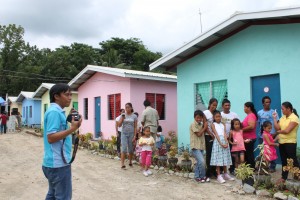AJUY, Iloilo-In the middle of the night, they would be awakened by seawater overflowing inside their houses. Their children would scamper from wet floors to dry areas in their house and most of the time, they would find themselves evacuating in a relative’s house.
This was the usual scenario in the lives of 200 beneficiaries of Core Shelter Assistance Program (CSAP) in Ajuy, Iloilo, who mostly used to live in the coastal barangays. Rising sea level would cause flooding resulting to damages in their houses made of light materials.
But that was before. For Carmelita Oliva, who now owns a unit at Brgy. Lanjagan, the long years of agony is over. She recently received her certificate of completion and acceptance of the shelter unit from DSWD regional director Ma. Evelyn Macapobre and witnessed by Mayor Juan Alvarez. The certificate gave them the go signal to already occupy the houses. The agency released P14 million at P70,000 each for the project. So far, 120 units are already complete; the latest batch includes the 10 units in Lanjagan. The remaining 80 units are under construction.
“We’ve had years when bad weather and high waves damaged our houses. But this time, we feel safer and protected because we already have sturdy shelter units,” said Carmelita.
Likewise, for 40-year-old Analyn Badon, the program has spared her children from getting flu often because they previously had a roof made of dried coconut leaves.
“My children would feel rain droplets on their faces while sleeping. Now, they can sleep well,” she said.
In the same way, Casilda Ringo said that she considers the shelter project as a blessing to her family. “The money we earn is just enough for food. We could never afford to build a house like this. I am so thankful that we now have an abode where I and my eight children can stay and feel safer,” she said.
CSAP is a rehabilitation program which aims to provide structurally strong shelter units that can withstand 180-220 kph wind velocity to families whose houses were totally destroyed by natural and man-made calamities and who have no capacity to build or construct their own units.
The project aims to reduce the number of homeless families every year by providing a structurally strong shelter and at the same time develop and promote the value of self-reliance among the beneficiaries and the community.
The DSWD releases funds for implementation of the project only to LGUs which already have lots, which are further certified safe by the Mines and Geosciences Bureau.
In the case of Ajuy, the LGU provided a counterpart of P40,000 per unit. Alvarez, on the other hand, donated the lots.
Regional director Ma. Evelyn Macapobre urged the beneficiaries to observe proper maintenance of their houses. “We will be happy when everytime that we will pass here, the shelters are well kept. If you do this, your children and grandchildren could even stay in the units,” she said.
Convergence area
Mayor Alvarez thanked the national government for implementing convergence strategy in the town.
The strategy, aimed at maximizing results rather than executing projects independently, is implemented by DSWD which pools its resources for beneficiaries of Pantawid Pamilya. They are also targeted for Sustainable Livelihood program (SLP) and KALAHI-CIDSS.
SLP accesses them to gainful employment and Micro-Finance Institutions (MFIs) or provides capital for those who are interested on entrepreneurship. KALAHI, on the other hand, is a poverty reduction program that uses a community-driven development approach. The program provides resources to poor rural municipalities for public goods investment and promotes people’s participation in government.
“I am happy that I will be able to leave this kind of legacy to my town,” said Alvarez./dswd6/May Rago-Castillo
